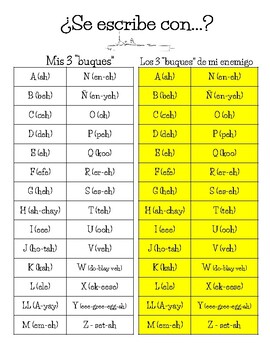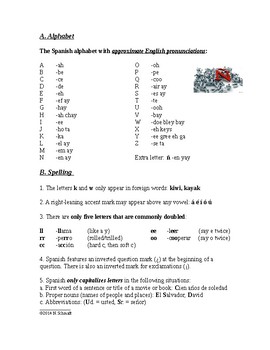
Although the letters ⟨k⟩ and ⟨w⟩ are part of the alphabet, they appear only in loanwords such as karate, kilo, waterpolo and wolframio (tungsten or wolfram) and in sensational spellings: okupa, bakalao. The Spanish language is written using the Spanish alphabet, which is the Latin script with one additional letter: eñe ⟨ ñ⟩, for a total of 27 letters.
 2.12 Writing words together and separately. 2.4 Optional omission of a consonant in consonant combination. The currently valid work on the orthography is the Ortografía de la lengua española, published in 2010. In contrast with English, Spanish has an official body that governs linguistic rules, orthography among them: the Royal Spanish Academy, which makes periodic changes to the orthography. The only other diacritics used are the tilde on the letter ⟨ñ⟩, which is considered a separate letter from ⟨n⟩, and the diaeresis used in the sequences ⟨güe⟩ and ⟨güi⟩-as in bilingüe ('bilingual')-to indicate that the ⟨u⟩ is pronounced,, rather than having the usual silent role that it plays in unmarked ⟨gue⟩ and ⟨gui⟩. This accent is used to mark the tonic ( stressed) syllable, though it may also be used occasionally to distinguish homophones such as si ('if') and sí ('yes'). Spanish uses only the acute accent, over any vowel: ⟨á é í ó ú⟩. francés, español, portugués from Francia, España, and Portugal, respectively) and book titles capitalize only the first word (e.g. Spanish uses capital letters much less often than English they are not used on adjectives derived from proper nouns (e.g. Spanish punctuation includes the use of inverted question and exclamation marks: ⟨¿⟩ ⟨¡⟩. The spelling is fairly phonemic, especially in comparison to more opaque orthographies like English, having a relatively consistent mapping of graphemes to phonemes in other words, the pronunciation of a given Spanish-language word can largely be predicted from its spelling and to a slightly lesser extent vice versa.
2.12 Writing words together and separately. 2.4 Optional omission of a consonant in consonant combination. The currently valid work on the orthography is the Ortografía de la lengua española, published in 2010. In contrast with English, Spanish has an official body that governs linguistic rules, orthography among them: the Royal Spanish Academy, which makes periodic changes to the orthography. The only other diacritics used are the tilde on the letter ⟨ñ⟩, which is considered a separate letter from ⟨n⟩, and the diaeresis used in the sequences ⟨güe⟩ and ⟨güi⟩-as in bilingüe ('bilingual')-to indicate that the ⟨u⟩ is pronounced,, rather than having the usual silent role that it plays in unmarked ⟨gue⟩ and ⟨gui⟩. This accent is used to mark the tonic ( stressed) syllable, though it may also be used occasionally to distinguish homophones such as si ('if') and sí ('yes'). Spanish uses only the acute accent, over any vowel: ⟨á é í ó ú⟩. francés, español, portugués from Francia, España, and Portugal, respectively) and book titles capitalize only the first word (e.g. Spanish uses capital letters much less often than English they are not used on adjectives derived from proper nouns (e.g. Spanish punctuation includes the use of inverted question and exclamation marks: ⟨¿⟩ ⟨¡⟩. The spelling is fairly phonemic, especially in comparison to more opaque orthographies like English, having a relatively consistent mapping of graphemes to phonemes in other words, the pronunciation of a given Spanish-language word can largely be predicted from its spelling and to a slightly lesser extent vice versa. #SPANISH SPELLING ALPHABET FREE#
Try a variety of games for the best results! The games are free to use and work on both tablets (including iPads) and desktop computers.Spanish orthography is the orthography used in the Spanish language. The games are quick and simple to play and improve language retention by excercising different areas of the brain. There are 12 free games you can use to practice the French topic you are learning at French Games.

By the time you have completed the whole lesson, you should be able to recall and repeat the vocabulary for each of the topic items without prompting. As you work your way through them, you will find that your grasp and retention of the target language gradually improves.

The 3 lesson activities are graded from easy to more difficult. During the introduction to the topic, it is important that you repeat the audio after you hear it, and write down the texts to help your memory absorb both the sound and look of that language. Each of our 100+ lessons consists of an introduction to the topic language and 3 lesson activities - a yes/no activity, an either/or activity and a multiple choice activity. Start your visit to French Games with the French Lesson for your chosen topic.







 0 kommentar(er)
0 kommentar(er)
